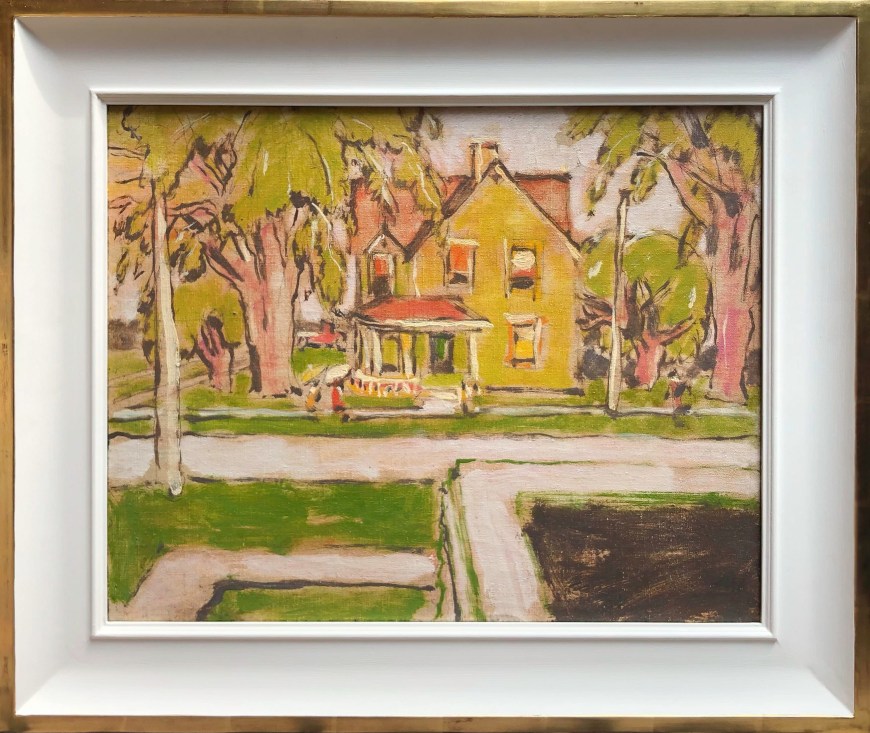-
Œuvres d'art
David MilneLambe's House (The Yellow House, Uxbridge), 1942 (May 15)1881-1953Oil on canvas16 x 20 in
40.7 x 50.8 cm
This work is included in the David B. Milne Catalogue Raisonne of the Paintings compiled by David Milne Jr. and David P. Silcox, Vol. 2, no. 403.113.SoldInscriptions
signed, [in 1946, per Silcox / Milne], ‘DAVID MILNE’ (verso, lower left); inscribed [by the Duncan estate], 655 (verso)Provenance
Mira Godard, Toronto, 1974;
Private Collection, Montreal.
Documentation
As cited in "David B. Milne: Catalogue Raisonné of the Paintings Volume 2: 1929 - 1953", p. 791:
"Primary Sources:
Kathleen Milne's notes on paintings, 4-14, 15 May 1942, MFP;
Milne to Douglas Duncan, 11 May 1942, MFP..."
David Milne Jr. and David P. Silcox, David B. Milne: Catalogue Raisonné of the Paintings Volume 2: 1929 - 1953, (Toronto: University of Toronto Press, 1998), no. 403.113, repr. p. 791.
This oil painting has a lushness and colour saturation that is one pole in Milne’s work, one that contrasts with his many relatively spare paintings. Precise as usual with the dating, Milne depicts a classic Ontario Victorian home in the spring, trees and lawns radiant. The sidewalks, streets, and the structure itself are rectilinear, but Milne balances this geometry with the large, thriving trees that frame the lot. Secondary are three figures – apparently female – walking in front of the house. We notice them almost incidentally. The two to the left are together: from Milne’s distance they are indistinct, perhaps so that we may imagine their appearance. One wears a yellow outfit only slightly darker than the house. The other is in red, and like her companion, is highlighted in white. What are they carrying? Unlikely as it would be in Uxbridge on a sunny spring day in the 1940s, both seem to sport parasols. Perhaps this is another of Milne’s figure fantasies. If so, it would chime with the imaginings of the most famous of all Western artists to paint a yellow house, Vincent Van Gogh. Is it possible that Milne is making an oblique reference to Vincent and to the Dutch artist’s cherished artists’ colony in the yellow house in Arles, France, which Vincent referred to as ‘Japan’? Milne’s figures certainly fit with our stock images of the far east. Sometimes a yellow house is not just a yellow house.
Van Gogh’s painting The Yellow House (1888) is one of his best known. He wrote to his brother Theo about it in September 1888: “The weather’s still fine here, and if it was always like that it would be better than the painters’ paradise, it would be Japan altogether.” Enthused about the house as a challenging subject to paint as well as a domicile and studio, he wrote “That’s a really difficult subject! But I want to conquer it for that very reason. Because it’s tremendous, these yellow houses in the sunlight.” Without suggesting that Milne knew or made reference to this exact context, he was familiar with Van Gogh’s radical art. Van Gogh was well represented in the Armory Show and much commented upon in the American press when Milne participated in this exhibition and lived in New York City. Whether self-consciously hinting at his own artistic lineage in the avant-garde or only providing an opportunity for us to do so today, Milne also took up the test of painting a large, mostly flat, and highly keyed yellow facade in what appears to be full sun. There are few shadows in either painting. Both artists intensified the yellow of the buildings, adding an emotional as well as a descriptive register to their paintings. Their similar emphasis on colour is also tied to a passion for the artists’ respective local environs as well as to the intensity of light: neither is just a yellow building but rather a specific house. Where Vincent’s small figures are recognizably Arlesian – one woman wears the distinctive local garb – the Asian-inflected appearance of Milne’s women in Lambe's House allows us to recollect Van Gogh.
Mark A. Cheetham
_________
http://www.vangoghletters.org/vg/letters/let691/letter.html
ibid













